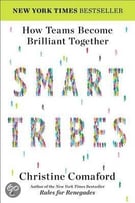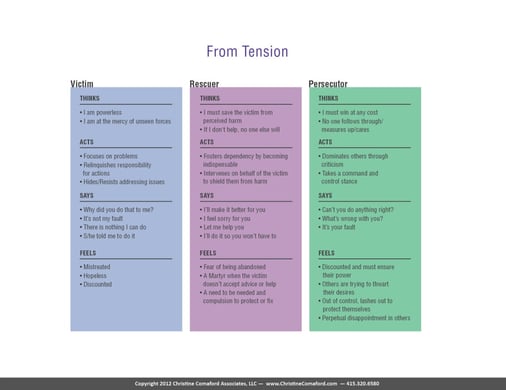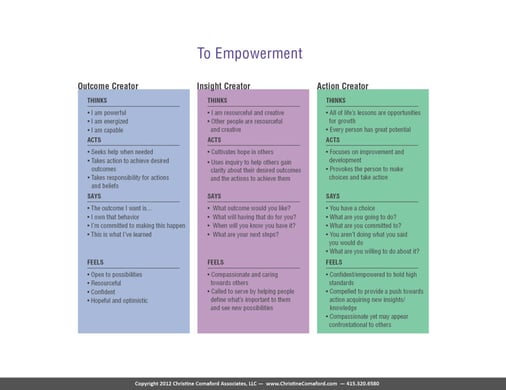 How awesome would it be to move yourself and the people you manage from a place where they are tense, anxious, and non-performing to inspired, innovative, outcome-focused and consistently achieving?
How awesome would it be to move yourself and the people you manage from a place where they are tense, anxious, and non-performing to inspired, innovative, outcome-focused and consistently achieving?
Read my last blog Victim, Rescuer, Persecutor: Which Role Are You Playing.
Did you decide which role you’re in?
Do you agree with the assessment we all are in one role or the other and these roles are interdependent upon each other?
If we consistently act in any of these roles we are in a Critter State as opposed to our Smart State. As a quick review remember that:
Smart State (From Smart Tribes by Christine Comaford): We have full access to creativity, problem solving, innovation, higher consciousness, and emotional engagement.
Critter State: Where we put ourselves and our teams into fight/flight/freeze, without access to our greatest resources.
Assess
Christine Comaford offers some ideas on how to determine which role you play if you struggle with defining this. What role do you often default to? (Hint: What role or roles did you play in your family as you were growing up?)
The more important question, once you determine your role: What is the result of being in this role—what does it “cost” you? What role do you think the key stakeholders in your organization see you in? How do you reinforce this? What percentage of your energy is spent on high-value activities? What did you learn from your Energy Allocation Chart?
I’ve determined I play the rescuer role. What has it cost me? At least two marriages certainly. In business, a lot of wasted time solving other people’s problems when I could have been working on an outcome I wanted instead.
You may wish to review the details of Smart State and Critter State which are the basis of Christine Comaford’s book Smart Tribes.
When we and our team are in Critter State, you and they respond to fear. Comaford notes, “Being problem-focused sucks our energy, leads us to look for ways to allocate blame, and feels constricting, like a jacket that’s too tight. Being outcome-focused is empowering and energizing, and fills us with confidence. It firmly places you in your Smart State, where possibility, choice, innovation, love, and higher consciousness are abundant.”
This quote from Comaford is worth noting, “As we shift from a problem- to an outcome-oriented focus and culture, something super cool happens: we shift ourselves.”
Super Cool: Outcome Focused
What if we could flip ourselves, from the role we consistently play, to our smart state? Even better what if we could flip the people we work with and who we depend upon to deliver results for our company to their smart state?
So here’s the reality. You can!
 When you understand your primary Tension orientation and flip it to its positive Empowerment counterpart, you encourage your team members to be internally motivated, to be fully accountable, and to take ownership of your organization’s key initiatives.
When you understand your primary Tension orientation and flip it to its positive Empowerment counterpart, you encourage your team members to be internally motivated, to be fully accountable, and to take ownership of your organization’s key initiatives.
Take a look at the first chart on Tension: Identify the role you play and then recognize how you think, act, say, and feel in the role you are playing. Also remember, these are roles the others in your “tribe” play when they interact with you in their specific roles.
By flipping your orientation you can achieve a better outcome. Imagine that? For example:
- The positive counterpart of the Victim is the Outcome Creator. All Victims want a certain outcome—this is what they are complaining about. Our goal is to help them focus on what they want, as opposed to what they don’t have or don’t like.
- The positive counterpart of the Rescuer is the Insight Creator. All Rescuers want to help save the Victim, yet they have tremendous skills that can help them enable the victim to save themselves.
- The positive counterpart of the Persecutor is the Action Creator. The persecutor wants to get momentum, to get a result.
Take a look at the Empowerment chart to see the contrast on how each role responds in terms of think, act, say, and feel.
 How To Do It:
How To Do It:
Identify each role you and the other person are playing. If you’ve not done this already go back and look at the first chart on Tension above. It’s important to know the role you play as well as the roles of each of your team members.
Once you’ve identified you and their role, speak to the other person as the positive counterpart.
- For example, my ex-wives were frequently in Victim mode. My tendency is to be a Rescuer. I should have been asking the questions of an Insight Creator (the positive counterpart of the Rescuer).
- If someone is in Rescuer mode and you tend toward Persecutor, speak to him as an Action Creator. If he is in Persecutor mode, ask him what actions he wants—speaking like an Insight Creator often works best.
Comaford recommends Hanging these figures 8-5 (From Tension) and 8-6 (To Empowerment) in your office. (I’ve done this already!)
Enroll others in helping you shift to your positive counterpart. This promotes candor and increases connection among colleagues.
Couldn’t we all use more of that in our relationships with others?
In Smart Tribes Comaford references the need for three vital qualities in the emotional state of our team: a sense of safety, belonging, and mattering.
When our team sees that we can work hard and not have to sacrifice ourselves to the cause, these emotional states in our co-workers skyrocket.
When we keep ourselves and our team members in their Smart State we achieve more effortlessly. We’ve all been in situations where work flows smoothly. We’re in a zone where we feel unstoppable. Being in our Smart State fosters this. Not only do we preform competently, we cultivate the same behavior in the people we manage. I encourage you to explore these charts focusing on how to empower your people. Identify your role, your people’s roles, then get their support to help you remain in your Smart State so you can empower them.
A customer I’ve worked with for some time has had several businesses. The past two years he and his team have enjoyed remarkable success, increasing revenue 50% to achieve his BHAG milestone.
In my role as business coach I facilitate their weekly meetings. One of my assignments is to make sure we invest the bulk of our time in Collective Intelligence. We’ve done a good job of this, still recently Lee asked me to increase this. At a recent Leadership Group Meeting he attend The Secrets Leaders Keep author, Amy K, suggested a number of ideas to improve Collective Intelligence to achieve better results. I’ll share these in my next blog.





.jpeg?width=150&height=135&name=Hand%20with%20marker%20writing%20the%20question%20Whats%20Next_%20(1).jpeg)

